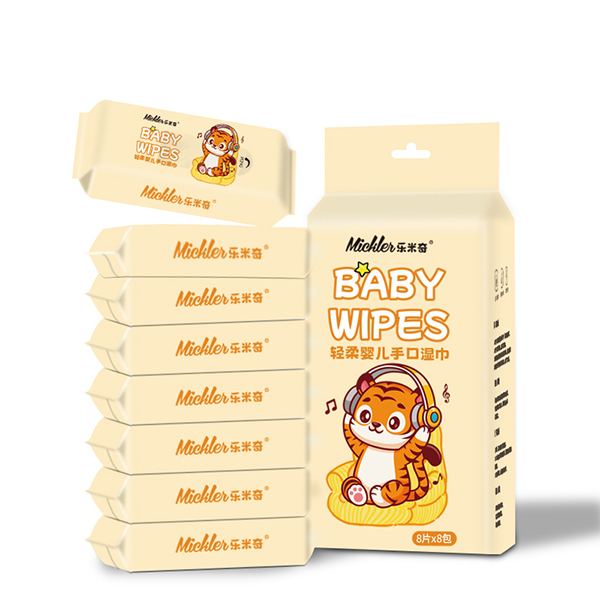
When caring for infants and toddlers, sticky spills from food and juice are a near-constant challenge. From smeared applesauce on a high chair to juice dribbles on tiny hands, parents and caregivers need reliable cleaning solutions that are gentle yet effective. Baby wet wipes are often the go-to tool for quick clean-ups—but are they truly effective for sticky messes?
Baby wet wipes are pre-moistened sheets made from soft, non-woven fabrics. They are saturated with a gentle cleansing solution, typically containing water, mild detergents, moisturizers, and sometimes preservatives or soothing agents such as aloe vera or chamomile. These ingredients are formulated to remove dirt, food residue, and other messes without irritating delicate infant skin.
Key characteristics that make baby wipes appealing include:
While these qualities make them ideal for diaper changes, their effectiveness for sticky food and juice requires closer examination.
Sticky foods and drinks pose a unique cleaning challenge because they adhere to skin and surfaces. Common examples include:
The effectiveness of baby wipes in tackling these messes depends on several factors:
Composition of the Wipe Solution:
Wipes that contain a small amount of mild detergent can break down sticky residues more effectively than water-only wipes. Detergents reduce surface tension, allowing the liquid to lift sugars, proteins, and fats from the skin.
Texture of the Wipe Material:
Non-woven fabrics with slight texture or embossing improve mechanical removal. Smooth wipes may merely spread the mess without fully cleaning it.
Volume of Moisture:
A sufficiently moist wipe can dissolve sticky residues more effectively. Wipes that are too dry may leave streaks or fail to lift thick food particles.
Time of Application:
Fresh spills are easier to clean than dried or congealed messes. Prompt use of a wipe increases success.
There are several reasons baby wet wipes are popular for cleaning sticky messes:
A pre-moistened wipe eliminates the need to find a cloth, bowl of water, or paper towel, which is especially useful in public spaces or during travel.
Unlike dish soap or household cleaners, baby wipes are formulated to minimize irritation. This is essential for hands, faces, and other sensitive areas.
Parents can carry a small pack of wipes in a diaper bag, stroller basket, or purse, ensuring they are always prepared for unexpected spills.
Baby wipes can clean more than skin—they work on high chairs, tables, and even toys, provided the ingredients are safe for contact.
While baby wipes are convenient, they are not a panacea for all sticky messes. Understanding their limitations helps set realistic expectations:
Sticky residues that contain sugars or oils may require follow-up washing with soap and water to prevent stickiness or microbial growth.
The concentration of cleansing agents and moisture level varies between brands. Some wipes may struggle with very thick or dried-on food.
While baby wipes are safe for skin, they are not formulated for deep cleaning countertops or floors. Large spills may require a towel and cleaning solution.
Most baby wipes are not biodegradable, and improper disposal can contribute to environmental issues. Frequent use for messy clean-ups can generate significant waste.

To maximize the effectiveness of baby wipes for sticky messes, consider the following:
Look for wipes that mention “mild detergent” or “extra cleaning power”. Fragrance-free and alcohol-free options are ideal for sensitive skin.
One wipe may not remove thick messes completely. Be prepared to use two or more for thorough cleaning.
Instead of scrubbing back and forth, which can smear the mess, gently wipe from the center outward. This helps lift residue without spreading it.
For sticky foods like honey, syrup, or yogurt, follow up with warm water to remove any remaining residue and prevent stickiness or irritation.
Embossed or textured wipes work better at lifting stubborn residues than completely smooth ones.
Carry a small pack in high-traffic areas—kitchen, car, stroller—so you can clean spills immediately. Prompt cleaning prevents residue from drying and becoming more difficult to remove.
While baby wipes are convenient, sometimes a combined approach works best:
Newborn skin is extremely sensitive. Use wipes labeled for “newborn safe” or “sensitive skin”. Avoid heavily fragranced or alcohol-containing wipes.
Toddlers often make larger messes. Wipes can clean hands, faces, and toys effectively, but may require multiple wipes or a follow-up rinse for thoroughness.
When cleaning up after allergenic foods (peanuts, dairy, eggs), thorough washing is preferable, as residues may trigger reactions if ingested.
Baby wipes are ideal for outdoor use when water access is limited. They can remove juice, fruit, or snack residue before returning the child to their car seat or stroller.
Baby wet wipes are a highly convenient and generally effective tool for cleaning sticky food and juice spills on infants and toddlers. Their soft material, gentle cleansing agents, and portability make them a staple in parenting routines. However, their effectiveness depends on the type of mess, the formulation of the wipe, and prompt use. While they can handle most fresh spills, particularly thick or sugary residues may require follow-up cleaning with water or mild soap.
For parents and caregivers, baby wipes provide a practical solution for quick clean-ups, helping maintain hygiene and comfort for little ones. Choosing the right wipes, understanding their limitations, and combining them with other cleaning methods ensures that sticky messes are managed efficiently and safely.
In short, while baby wet wipes may not replace a full wash in every scenario, they are an indispensable first line of defense against the sticky chaos of feeding time.
